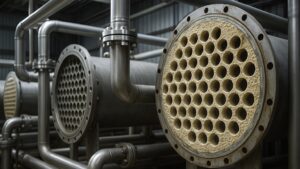Gigafactories are assuming a central role with time as the EV space is growing. These large facilities producing batteries apart from the production line and high tech demands one other requirement. This requirement is for precise control of humidity levels in the plant. This is where a gigafactory dry room comes into the picture.
Specialized enclosures designed to sustain extremely low humidity levels are called gigafactory dry rooms. Thus, they are essential to preserving the integrity and caliber of battery cell production. As the facilities require controlled environments, even a trace of moisture can compromise the whole sensitive process. It can also lead to defects or degrade in performance. As a result, using dehumidification systems has become imperative for gigafactories to maintain humidity levels.
In this article, we will dive deep into dehumidification systems for optimizing gigafactory dry rooms. So, let’s dive in.
Gigafactory Dry Rooms: Dehumidification Technology Options
To maintain low humidity levels in dry rooms, there is a necessity to keep advanced technologies in employment. Moreover, these systems need to be efficient, durable, and adaptable to the demands of the business of battery manufacturing projects. So, let us take a look at the different technology options for gigafactory dry rooms:
Desiccant Dehumidification Systems
The system is widely used in commercial and industrial settings. These are especially the ones that need to regulate low humidity levels. It makes use of principles of absorption. In this, a desiccant substance selectively removes the moisture from the air stream.
Solid Desiccant Systems
In solid drying systems, there’s a special material called a desiccant. It’s put in a wheel or belt that spins around. This desiccant draws moisture from the air as it passes through it, just like silica gel does. Even at extremely low temperatures—like -100 degrees Celsius—it aids in keeping the air dry. Furthermore, periodically cleaning the desiccant is required to get rid of the moisture it has absorbed. Gas or hot air is blasted through it to accomplish this.
These systems work well for large gigafactory dry rooms since they are modular and adaptable to meet a variety of situations. Combining them with other energy-saving systems enhances their performance. Solid desiccant systems excel at reliably controlling humidity in settings with stringent product requirements, such as large factories requiring very low humidity.
Liquid Desiccant Systems
The systems make use of liquid solutions to remove moisture, such as lithium chloride/lithium bromide. The wet air meets this liquid solution directly, which helps soak up the moisture. Then, the weak solution gets heated up to get rid of the moisture it absorbed. These systems can make the air dry, even below -40°C (-40°F). They can save energy because they reuse heat and don’t need to be heated up too much to work again.
But, they need regular care to make sure the liquid solution stays good and doesn’t get mixed with the air. Liquid drying systems can work well for huge factories, but only if they’re looked after properly.
Both solid and liquid drying systems have good things about them, but they also have some problems. To get the most out of them in big factories, people need to design them, run them, and keep them in good shape very carefully.
Cryogenic Dehumidification Systems
Cryogenic dehumidification systems provide a revolutionary way to precisely manage humidity. They work by bringing the air’s temperature down to unusually low levels, like below -100°C (-148°F), which leads to the condensation and evaporation of moisture. These systems are great for places like gigafactories that need super dry conditions.
It has a few important parts: a cooling system that uses two stages, things to cool the air, devices to get rid of the ice that forms, and heaters to warm the air back up to the right temperature. These systems can eliminate even the smallest moisture particles from the air by drastically chilling it; the air can be made as dry as -100°C (-148°F).
These systems have certain issues despite being excellent at managing humidity. They require professionals to put them up and operate, consume a lot of electricity, and ice can accumulate on elements that need to be removed regularly. But despite these issues, they’re still really promising for keeping gigafactory dry rooms super dry, especially as we find better ways to save energy and make the systems work even better.
Membrane Dehumidification Systems
Special systems that remove humidity use a different method. They use special filters that let certain things pass through. There are two main types of these systems:
Vapor Compression Membrane Systems
The system works by making use of a cooling process to chill the air. So, it transforms the moisture into droplets of water. Furthermore, it utilizes a special filter to separate the cool and damp air from the warm dry air. The filter allows the water vapor to move through, leaving the dry air behind. It then warms up the dry air again and sends it into the room that requires dryness.
Liquid Desiccant Membrane Systems
Liquid drying systems with membranes use a special liquid to dry the air. This liquid, often made of lithium chloride or lithium bromide, flows on one side of a barrier, while the damp air moves on the other side. The barrier allows the moisture in the air to pass through and the liquid absorbs it, reducing the humidity of the air. Later, the liquid heats up to release the trapped moisture, making it available for reuse.
These membrane drying systems have some good points. Small in size, they occupy minimal space, can be assembled in small segments, and efficiently utilize energy, particularly when paired with specific cooling systems. They can even make the air dry, suitable for places that need very low humidity.
But there are also some problems with them. The barrier can get dirty or wear out, they might not work well for big areas, and they can be tricky to set up and run smoothly, especially in really big factories.
Challenges of Humidity Control in Gigafactory Dry Rooms
Maintaining precise and accurate control over humidity levels inside the tremendously large gigafactory dry rooms of gigantic battery manufacturing plants is an immensely difficult undertaking. This immense difficulty arises from the colossal scale involved and the stringent requirements of these facilities. It necessitates ingenious solutions and overarching strategies to ensure dependable and efficient operations are achievable.
The enormity of Scale and Uniformity Needs
One of the foremost challenges is the epic proportions of the dry room spaces in these immense plants. It often spans many hundreds of thousands of square feet in area. Accomplishing consistent and even humidity conditions across such vast expanses without the formation of problematic variance zones or stagnant pockets is an arduous feat to overcome. The dehumidification systems must be capable of handling monumental volumes of airflow. It should also simultaneously sustain uniform conditions throughout. Thus, mandating meticulous system design and strategic placement of equipment components.
Ultra-Low Humidity Targets for Manufacturing
The ultra-low humidity targets requisite for battery cell manufacturing activities, with dew point levels plunging well below the -40°C (-40°F) mark, further intensifying the complexity involved. Attaining and maintaining such minimal humidity levels is an energy-intensive endeavor. It necessitates careful optimization of system designs to curb operational expenditures and minimize environmental impact.
Stringent Cleanliness and Particulate Elimination Requirements
These dry room environments must adhere to exceedingly stringent standards of cleanliness. It is frequently classified at the ISO Class 5 level or higher caliber. It prevents any particulate matter or molecular contamination. These could compromise the performance and safety aspects of the battery products. Upholding these stringent levels of cleanliness while facilitating the indispensable airflow and humidity control processes presents a formidable challenge to overcome.
Integration of Systems and Redundancy Contingencies
The seamless integration of dry room systems with other critical facility components, such as HVAC, cleanrooms, and material handling processes, is imperative. This is for achieving truly cohesive and efficient overall operations. Coordinating the synchronized operation of these interconnected systems, while simultaneously ensuring the presence of fail-safe mechanisms and redundant contingencies to maintain prescribed environmental conditions during instances of system failures or maintenance events, demands painstaking planning and execution.
Gigafactory Dry Rooms: Designing for Optimal Dehumidification Performance
Realizing dependable and efficient dehumidification capabilities in the gigantic dry room environments of battery manufacturing plants necessitates a comprehensive design approach. It should be one that takes into consideration a multitude of factors. It ranges from system sizing and layout to seamless integration with other crucial facility systems.
System Sizing and Dehumidification Load Calculations
Proper sizing of the dehumidification systems is of utmost importance. Determining the required dehumidification capacity involves a very detailed analysis of variables. It includes the dry room’s huge volumetric dimensions and surface area, the rates of air changes and the desired target humidity levels. It also includes any moisture loads from processes, rates of air leaking in and out, as well as careful allowances for safety factors and backup requirements. Failing to properly account for these variables can result in dehumidification systems that are either too small or too big. As a result, it leads to inefficiencies, inadequate humidity control, or excessive energy consumption.
Unit Placement and Air Distribution Methods
The layout and positioning of dehumidification units within the dry room environment are extremely important factors. They greatly influence the ability to achieve uniform humidity control. It also prevents the formation of undesirable areas with too much or too little humidity. Strategic unit placement, guided by comprehensive analyses of airflow patterns and informed by air distribution methods (e.g., ceiling-based, underfloor, or mixed configurations), can effectively target high-moisture load areas. It can also minimize obstructions or dead zones that could potentially disrupt optimal airflow.
System Integration and Control Mechanisms
Effective integration with other critical facility systems, such as HVAC, cleanrooms, and material handling processes, is essential. This is for achieving seamless and energy-efficient overall operations. Coordinating the synchronized operation of the dehumidification system with HVAC systems for temperature control, air circulation, and heat recovery can result in substantial energy savings. Implementing airlock systems and pressure controls helps prevent humidity and contaminants from entering adjacent spaces. So, it thereby preserves the stringent environmental conditions within the gigafactory dry rooms.
Enabling centralized monitoring and control by interfacing with building automation systems (BAS) and supervisory control systems ensures optimal system performance. It also ensures rapid response to any deviations from desired conditions. Incorporating redundancy measures and fail-safe backup mechanisms further bolsters the reliability of the overall system. Furthermore, It maintains prescribed environmental conditions during system failures or maintenance events.
To Sum Up
Making dehumidification systems in gigafactory dry rooms work better has become a very important task. It allows gigantic battery factories to achieve and maintain the extremely low humidity levels needed for making high-quality battery cells consistently. To stay ahead of these developments and learn about the latest advances in the design and construction of gigantic battery factories, industry professionals should attend The Global Summit on Gigafactory Design & Construction.
Berlin, Germany will host this premier event on April 18–19, 2024. It provides a special opportunity for collaboration, networking, and information sharing. Global innovators, experts, and decision-makers will come together to help define this quickly expanding industry’s future. They will talk about fresh concepts for planning and constructing the enormous plants required to fulfill the growing demand for batteries. Register today!





